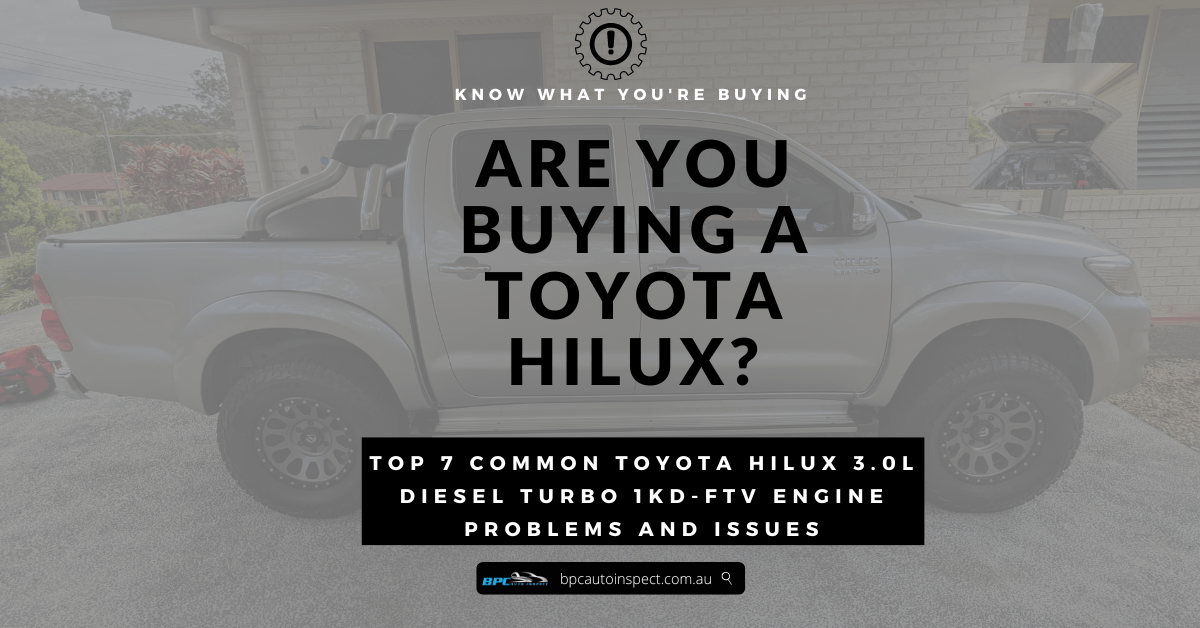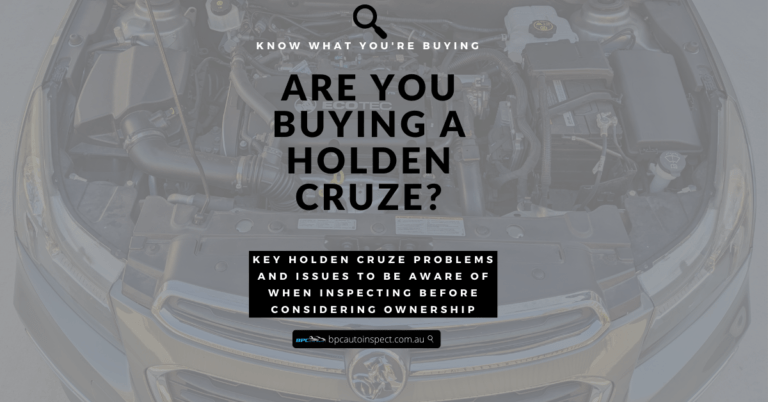Toyota Hilux Problems – Common Issues & Solutions
Toyota Hilux Problems are easy to identify with issues from turbo failure, loss of power and even oil leaks. Here are the top 7 with inspection tips.
In this article
Common Toyota Hilux Problems
The Toyota Hilux is known for its durability and reliability, making it a popular choice among tradespeople, adventurers, and utility vehicle users. Despite its reputation, the Hilux is not immune to issues. Here are seven common problems Toyota Hilux owners have experienced.
1. Turbo Troubles
The turbocharger is crucial for the performance of diesel Hilux models. Problems such as a split intercooler pipe, actuator, worn turbo bearings or a failing turbo can result in power loss, excessive black smoke from the exhaust and unusual noises. These issues can be expensive to repair. Pay attention to any signs during test drives, like smoke or sluggish acceleration. You can buy an aftermarket replacement Toyota Hilux Turbo Intercooler (eBay affiliate link) and pipes.
2. Misfiring and Starting Problems
Owners of common rail diesel Hiluxes may encounter issues with diesel fuel injectors, leading to misfiring and starting difficulties, including decreased fuel efficiency, similar to the Toyota V8 diesel engine problems that arise from injectors.
3. Injector Seals Leaking
The Toyota Hilux KUN26R, manufactured between 2005 and 2015 and equipped with the 1kd-FTV engine, faced a known problem related to injector seal leaks. These leaks were responsible for causing issues within the oil system, potentially damaging the engine.
Here’s a breakdown of what went wrong:
- Faulty Injector Seats: Initially, the 1KD FTV engines utilised copper injector seats. However, copper was not the best choice for this purpose as it tended to soften and deform over time, leading to leakage of combustion gases past the seal.
- Leakage and Oil Contamination: The leaks from the injector seals allowed blow-by gases from combustion to enter the crankcase. This mixture of gases with engine oil resulted in thickening and sludge formation.
- Blocked Oil Pick-up: The thickened oil could clog the oil pick-up screen, causing a restriction in oil flow to the engine. This lack of lubrication could lead to wear on engine components and potential failures.
While some countries like New Zealand initiated a recall for this issue, not all regions were included – it appears that Australian models might have been excluded from recalls. Nonetheless, many Toyota dealerships were aware of this problem. They often addressed it by replacing the injector seats with a durable design during routine servicing if any symptoms were detected.
Toyota doesn’t specify a regular replacement interval for the injector seals in the 1KD-FTV. However, many mechanics suggest replacing the injector seals for older models (pre-2009) that still use copper seats due to known issues. At the same time, have the injectors checked, or you can buy replacement Toyota Hilux injectors* (eBay affiliate link).
Signs of Injector Seal Leaks:
- Watch out for smoke during starts, engine rattling noises and decreased performance
- Rising oil level because the diesel is leaking into the engine’s sump
- When doing an oil change, inspect the oil pick-up for blockage through the sump drain hole using an Endoscope Camera* (Amazon affiliate link)
If you have a Toyota Hilux KUN26R with the 1KD-FTV engine, it’s smart to be alert to leaks from the injector seals. Seeking advice from a mechanic with these engines can help you decide if replacing the seals preventively is an idea for your specific vehicle.
4. Power Loss
If your Hilux seems sluggish or doesn’t have its usual grunt, the Exhaust Gas Recirculation (EGR) valve could be causing the issue. The EGR valve reduces emissions by feeding exhaust gases back into the engine. Over time, these gases can leave deposits that block the valve, hindering performance. Cleaning the EGR valve and around the intake system, or in some cases replacing the EGR altogether, can restore power.
5. Leaking Oil from Crank Seal
Hilux models have a known issue with oil leaks from the crank seal. This can create a situation. Potentially harm other engine parts if not dealt with promptly. If you see oil under the engine towards the front, it’s advisable to degrease the area and monitor it to accurately diagnose that the oil leak is coming from the front crank seal.
6. Challenges with 5th Gear Synchronisation
While less common than the other problems on this list, some Hilux owners have reported difficulty engaging 5th gear. This is likely due to worn synchronizers in the gearbox. If you’re looking at a used Hilux, pay attention to how smoothly the gears shift, particularly into 5th. Also, listen for any whining sound coming from the rear differential.
7. Issues with DPF (Diesel Particulate Filter) (Relevant for Later Models)
Later Toyota Hilux models have a Diesel Particulate Filter (DPF) on the 2.8-litre 1GD-FTV four-cylinder turbo diesel engines. This filter captures soot particles from exhaust emissions to reduce emissions impact in built-up areas. If the vehicle is not taken out on the highway regularly, the DPFs can get blocked over time, causing the DPF warning light to come on, a drop in performance and higher fuel usage. A mechanic can perform a forced burn to regenerate the DPF at their workshop. If the issue is severe, replacing the DPF might be necessary.
How to Avoid a Clogged DPF
A clogged DPF (Diesel Particulate Filter) can cause trouble for Toyota Hilux owners. The good news is that there are ways to prevent this issue and keep your Hilux in good shape.
To keep your DPF in good shape, follow the tips below and consider using an OBD2 scanner that can monitor the filter’s health and perform a manual regeneration when needed. For this, the Autel MaxiAP AP200 OBD2 Scanner* (Amazon affiliate link) is an excellent choice for a Toyota Hilux to manage your DPF and avoid costly repairs proactively.
Here are some important tips:
- Take Regular Highway Drives. DPFs need a process called regeneration to burn off soot particles. This usually happens automatically at highway speeds. Try to drive for 20 to 30 minutes at speeds of 65 to 90km/h to help the DPF regenerate properly.
- Avoid Short Trips. Short stop-and-go trips don’t let the engine get hot enough for DPF regeneration. If you mainly take short trips, try to include a highway drive once or twice a week.
- Reduce Idling. Excessive idling doesn’t help with DPF regeneration and can lead to soot buildup. Avoid idling for the period, especially when starting the engine in cold conditions.
- Use the Recommended Engine Oil. It’s important to use the engine oil specified by Toyota. The type of oil used affects the DPF regeneration process. Make sure you’re using the recommended oil grade.
Don’t overlook warning signals. If the DPF warning light appears on your Hilux dashboard, it’s crucial not to dismiss it. This light signals an issue with the DPF system that may need addressing. Refer to your owner’s manual.
Refer to information from Toyota about Diesel Particulate Filters (DPF) and the DPF class action relating to certain HiLux, Fortuner & Prado diesel vehicles.
Diesel Particulate Filter (DPF) manual regeneration switches are fitted as standard production features on Prado, Fortuner and HiLux vehicles from June 2018, LandCruiser 200 vehicles from August 2015, LandCruiser 70 vehicles from August 2016, Hiace from June 2016, new generation Hiace from February 2019 and Granvia from July 2019 and Coaster buses from August 2006. If you have any questions about DPF manual regeneration switches, please contact your Toyota Dealer or the Customer Assistance Centre on 1800 869 682 (Monday to Friday 9am to 5.30pm AET).
During maintenance checks, some mechanics suggest incorporating a DPF cleaning solution into the fuel tank. These solutions can help decrease soot accumulation and enhance DPF functionality. However, it’s advisable to consult with your mechanic before using additives to confirm their compatibility with your Hilux model.
By adhering to these suggestions, you can notably lower the chances of your Toyota Hilux DPF getting clogged. Ensure a period of trouble-free driving. A well-maintained DPF enhances fuel efficiency and engine performance. It also benefits the environment.
Tips for Buying a Car from a Seller
When purchasing a Hilux from a private seller, you might be asking, Are pre-purchase inspections worth it? The obvious answer is yes, because it could save some money, but you will gain an insight into the vehicle’s history – if it has been used for its intended purpose, like four-wheel driving on the beach or an ex-mine vehicle.
Thinking of Buying a Used Hilux?
Before you buy, review a real Toyota Hilux pre-purchase inspection report to see what issues were identified and what to inspect. This type of detailed review can help you avoid costly repairs and make an informed decision with confidence.
If you want to book a 4wd pre-purchase inspection so you can get the facts, we can help.
Maintenance Advice
Regular maintenance is essential for keeping your Hilux in condition and preventing issues. Adhere to the manufacturer’s recommended service schedules. Use high-quality oils and fluids. Listen for any sounds, vibrations or warning lights from your Hilux as they could indicate problems. Dealing with problems promptly can help prevent them from escalating into costlier issues further down the road.
*As an Amazon Associate and eBay Partner I earn from qualifying purchases. This post may contain affiliate links to products I recommend.
Also Please Note: The information contained on this page is for general information purposes only. All reasonable steps have been taken to ensure that this information is accurate, complete and up-to-date. Also if you believe any information we have displayed is inaccurate, please contact us immediately and we will take reasonable steps to correct it. Finally, this information is a guide only and cannot be used as a reference to the point of law.
✅ Need a Pre-Purchase Car Inspection?
Don’t risk buying a lemon. At BPC Auto Inspect, we provide detailed mobile vehicle inspections across Brisbane. Fast, thorough, and independent.
🚗 Book a Mobile Inspection






